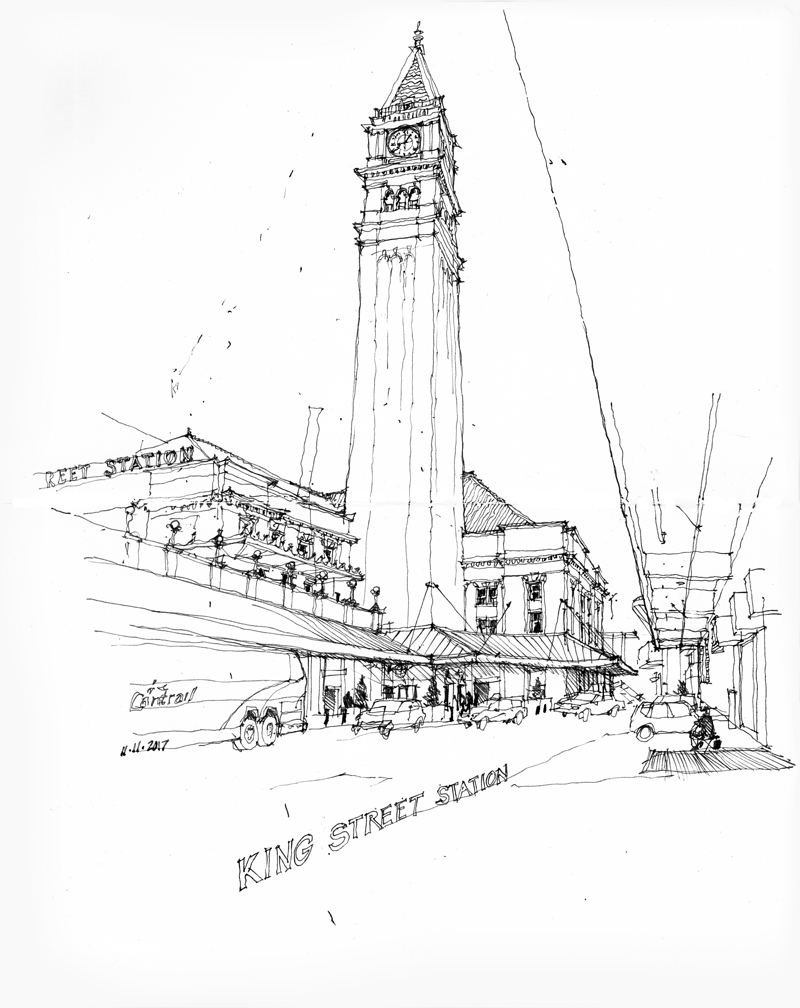More examples of how changes in media affect not how one sees, but rather how one captures what is seen—the pace of the line, the level and precision of detail, and the voids that speak to the eye.

The several times I had the privilege of teaching in the University of Washington’s Architecture in Rome program, I asked my students to keep a journal during the semester to record and document their history walks, field trips, and design studio work. To try and set an example, I kept my own sketchbook along with them. Here are a few sample pages showing how my drawings changed due to the passage of time as well as how my trusty Lamy fountain pen interacted with the different types of paper I used.
 On Saturday, November 11, 2017, Seattle Urban Sketchers met at King Street Station to help mark the 10th anniversary of USk. USk chapters around the world, beginning in New Zealand and ending in Honolulu, participated in this Global 24-Hour Sketchwalk.
On Saturday, November 11, 2017, Seattle Urban Sketchers met at King Street Station to help mark the 10th anniversary of USk. USk chapters around the world, beginning in New Zealand and ending in Honolulu, participated in this Global 24-Hour Sketchwalk.
Completed in 1906 to serve both the Great Northern and Northern Pacific railways, King Street Station now serves Amtrak and the Sound Transit Sounder commuter trains. The Minnesota firm of Reed and Stem designed the station, which was listed in the National Register of Historic Places and the Washington Heritage Register in 1973. The tower featured in this sketch, with its height slightly exaggerated, was modeled after the Campanile in the Piazza San Marco in Venice.
Sakya, one of the four major schools of Tibetan Buddhism, is named after the patch of gray (kya) earth (sa) in southern Tibet on which its first monastery was erected in 1073. In contrast, this Sakya Monastery in the north Seattle neighborhood of Greenwood is housed in a former Presbyterian church built in 1928. After outgrowing several other facilities in Seattle, the local Sakya community moved here in 1984. This location was seen as being auspicious because the number 108 in its address is sacred in Tibetan Buddhism.
Rather than being a monastery, this is more a community of lay practitioners that was led by His Holiness Jigdal Dagchen Sakya Rinpoche, who immigrated to the U.S. with his family in 1960 as exiles after the Chinese invasion of Tibet. One of the first Tibetan lamas to settle and teach in the U.S., he passed away last year at the age of 87.
At the corner of the site where NW 83rd Street meets 1st Avenue NW is erected a white bell-shaped stupa in memory of Dezhung Rinpoche III, who had co-founded with Jigdal Dagchen the original Sakya Dharma Center in Seattle in 1974. The stupa, symbolizing the Buddha’s enlightened mind, is surrounded by four quadrants of prayer wheels